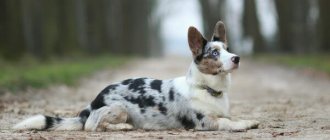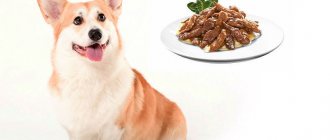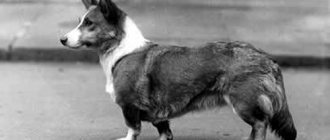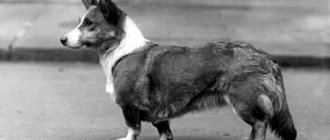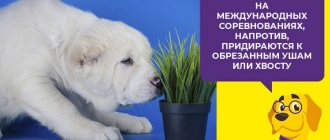What types of tails do corgis have?
First of all, it should be noted that the differences in the tails of representatives of this breed depend on the type of corgi. Dogs of the Welsh Corgi Cardigan variety have always had tails and have never been docked. Representatives of the Pembroke Welsh Corgi breed can have tails of different lengths.
Why doesn't a corgi have a tail? Reasons for this:
- Congenital bobtail.
- The tail process was docked.
- spirally twisted like a corkscrew;
- thrown over the back, like a fox's;
- in the form of a lowered saber.
Short from birth
The appearance of puppies with congenitally short tail processes is caused by the presence of the bobtail gene in the genotype of the parents. If such a gene is absent, the offspring will definitely have a tail. Some breeders are interested in ensuring that puppies are born only with bobtails. For this purpose, they specially form litters.
Short docked (A brief excursion into history - why such a tradition arose and how long the process is left now)
From the moment the Pembrokes appeared until the end of the 20th century, there was a tradition of docking their tails. This practice was originally carried out because corgis were herding dogs. To prevent the tail from being stepped on and injured by thorns, the dogs were subjected to a circumcision procedure.
However, the reason for docking was not only to preserve the health of the corgi. In the 18th century, a tax was introduced in England on the length of a dog's tail, since it was believed that long-tailed pets belonged to hunting animals. To avoid paying tax and protect themselves from the mark of a poacher, the owners cut off this part of the animal’s body.
Over time, the tax was abolished, but docking continued, because such tails were one of the exterior qualities of the breed.
It is believed that the result of docking should be a tail extension that is minimal in length. Some breeders leave it at 1-2 vertebrae so that the dog can wiggle something.
Almost universal docking of corgis led to the loss of the short tail gene. Congenitally bobtailed individuals existed in small numbers in a few nurseries and private breeders.
Until the 90s of the 20th century, Pembrokes had their tails docked, until this procedure was banned in many countries around the world. After him, attention to the congenitally short-tailed Pembroke was renewed.
Long
After the ban on docking was introduced, breeders began to pay attention to the appearance of individuals with long tails of various shapes. They can be:
There is also a lot of controversy surrounding the long-tailed Pembroke. This is due to the fact that not every dog is decorated with this part of the body. It all depends on the pet itself, and on the type, shape, and fluffiness of the tail. In corgis, this data is unstable.
Pembrokes and tails.
The absence of a bark tail with a ring on the back is
an undeniable “plus” in the appearance of a charming Pembroke!
When the site was first laid out, I did not have an exact personal opinion on what the Pembroke should look like from the back.
But now I confidently say - only to the tailless! Without imposing my opinion on anyone, I will say that the presence of a tail gives the Pembroke a resemblance to a cute “chestnut”.
And I’m not talking about exhibitions now - traditionally, one third of the entire livestock of a club or kennel appears at exhibitions, regardless of the breed of dog.
This is statistics.
The remaining two-thirds of the dog population live and simply delight their owners without showing at all,
with tails, without tails, full-toothed, failed “stars”, or an unidentified breeding marriage.
However, I definitely decided for myself that there would be no tailed Pembrokes in the nursery.
As long as docking is not prohibited in Russia, I will always dock the tails of Pembroke puppies.
And it is not discussed.
When people call me and ask for a dog with a tail “like a fox”, I ask if they would like to end up with a tail “like a little dog” in a tight ring thrown over the back?
The answer is usually no.
But the Pembroke will most likely have just such a tail!
This is how this dog is built.
Plus, let’s add to this the fact that selection and selection based on the position and shape of the tail is not carried out in our breed!
Docked sires are used, and no one knows what kind of tail this dog might have had if it had one.
And since the characteristics (position, shape, length, hairiness of the tail) are inherited from ancestors... is it necessary to continue?
Hence, we increasingly see at exhibitions beautiful dogs with ugly ring tails thrown over their backs.
| a short bob is visually completely indistinguishable from a docked ponytail |
The bob looks a little longer like in the photo |
an undocked bean can look like this |
Boobtail. Heritability of the trait (more details here: Pembrokes - natural bobtails
Mikheeva Ekaterina, "from Xaro Fair Game",
engaged in breeding bobtails:
“Of course, for a Pembroke-Bobtail to appear, one of the parents must be a Bobtail themselves. The bobtail gene is inherited only as a dominant trait. However, from my male there was one litter of three puppies where there was not a single short puppy, as well as two litters (six and four puppies) where all the puppies were natural bobtails. The length of the bob is not predictable. I once had a puppy who was missing only a white tuft at the end of his tail. The DNA test confirmed that this puppy (female, Santerra from Xaro Fair Game, Dnepropetrovsk) is a born bobtail.”
Kuznetsova Natalya , owner of the Gemini ,
engaged in breeding bobtails:
“In my kennel, from a male with a docked tail and a bob-tailed bitch, out of five puppies there were two short puppies. In the second litter from another male and the same bitch, but also with a docked tail, out of five, not a single bob was born. And in the third litter there are six from a male with a long tail and all are bobtails. Three tails are short and Three is slightly less than half."
Actually, this confirms that there is no need to look for bobtails where they cannot be found, that is, from a long-tailed or docked pair of dogs!
Unfortunately, there has now become quite a lot of manipulation with false bobtails.
It’s so simple: write the puppy’s cherished farm breed (an abbreviation recognized by RKF, meaning “bob-tailed”) in the document of origin.
and sell such a puppy for exhibitions abroad or to foreign owners.
But this fact is solely on the conscience of this would-be breeder.
And I advise those who want to buy a true bobtail not to forget,
that for a bobtail to appear, one of the parents must have a natural bob!
Well, or puppies should have a test.
Opinion on the ban on docking.
I really hope that this cup will pass from us, and in our country we will still be able to preserve the true appearance of the docked Pembroke as it should be.
For the sake of the “green” movement, there is no need to “bend in” and unanimously preach double standards when tail docking is elevated to the rank of a crime. However, along with this, sterilization of female dogs (complex abdominal surgery under general anesthesia), castration of cats and males (painful operation), and amputation of fingers for cats (under general anesthesia) are actively promoted. And this is just to make it convenient for a person! No more - just think about it - these harsh manipulations with an animal do not carry any more meaning!
You need to “turn on” your head and understand that docking the tail of a three-day-old puppy is much less painful and without the use of anesthesia than a full-fledged operation on an adult animal!
Just think about it.
Modern tailing standards
Modern corgi tail standards vary. The main difference is at what level the Pembroke's undocked tail should be set.
European
The English Kennel Club stipulates that the Pembroke's tail should be positioned in line with the back. In an excited state and in motion, its normal position is slightly above the topline.
Russian
The Russian Cynological Federation introduces its standards for Pembroke tails:
The breed's roots lie not in the marble halls and gilded bedrooms of prim nobility, but in the hoof-trodden muck of the pasture paddocks and muddy hovels of 12th-century Wales.
In fact, the history of the origin of any ancient breed, including the Pembroke Welsh Corgi, is little known. According to one version, the name of the breed comes from the phrase “cor” “ci”, which means “dwarf dog” in Welsh. This version is similar to the truth: a squat, stocky, but at the same time fast and resilient dog was bred to herd livestock, hunt rats in the stable, and drive herds along the narrow paths of Wales to the market squares of London. In a word, an assistant on the farm, but small in size, so as not to ruin the farmer with his appetite. Celtic farmers are cheerful, romantic, impulsive people, they love to joke about the short legs of the corgi : “a dog with filed legs fits perfectly under a bench while the owner, after a hard day’s work, relieves fatigue over a pint of ale in the local pub.” The Pembroke Welsh Corgi is a Welsh Sheepdog and is an ideal reflection of the national qualities of the Welsh, who, despite their outward simplicity and modesty, quite sincerely consider themselves the personification of all virtues. But the main advantage of representatives of this breed is their positive attitude and sense of humor.
As for the more official versions of the origin of the breed, one of them claims that the ancestors of the Pembroke Welsh Corgi came to Great Britain in the 12th century along with Flemish weavers who came to Wales at the invitation of the English king Henry I.
The second version says that the first representatives of the Welsh Corgi were brought to the territory of the British Isles by Swedish merchants (this is evidenced by the similarity of the Pembroke to the Swedish Vallhund). According to the third theory, the Pembroke Welsh Corgi descended from ancient Icelandic dogs, which are considered long extinct.
In general, scientists still have a lot to think about - none of the existing versions has conclusive evidence.
The most common description of the Pembroke is “a big dog in a small body.” Most often, this breed is started by people who once owned large dogs and decided to switch to something smaller, but so that the dog would not be a “trembling creature”, but would be trainable. The Pembroke Welsh Corgi is an ideal dog for a person with an active lifestyle who loves to travel. Corgis are intelligent, moderately active, and "always ready." They are accustomed to being the center of attention and have a wonderful sense of humor.
There are only two disadvantages to Pembrokes: they shed quite noticeably (like any other dog with a thick undercoat and dense outer coat), and Pembroke bitches may have a complicated birth, requiring the presence of a veterinarian and, with a probability of about 50%, a cesarean section.
A common mistake is to think that this is a small couch dog - people who think this way are wrong. At heart, every Pembroke Welsh Corgi feels like a big and significant dog, so for beginners who have this first dog, I always advise working with a training specialist - he will teach the owners how to handle the dog so that it does not sit on their neck and does not start with them. lead (the Pembrokes, with their incredible charisma, do this masterfully).
What does a Pembroke Welsh Corgi look like?
The Pembroke Welsh Corgi is a strong, squat and hardy dog, 26-30 centimeters high at the withers, weighing 12-15 kilograms. The Pembroke's head is similar to a fox's, but without the cunning expression inherent in a fox - he has a sweet, inviting face with a wide, welcoming smile.
Length – 40% greater than the height at the withers, i.e. This is an elongated dog. Pembroke Welsh Corgis are friendly by nature and, contrary to popular opinion, are not at all suited for guarding or defense - any aggression towards a person is considered a disqualifying vice.
There are 3 color options in the breed: classic red-and-white (from sandy-red to bright red), which is most common, tricolor in two variations: with a red head and a rare black-headed tricolor, as well as sable and white color. All of them are shown in the same ring, not in exhibitions, and do not have any significant differences in appearance. Dogs of different colors are allowed to breed with each other without restrictions.
For many years, the “face” of the breed was the wonderful tailless butt. Previously, it was customary for all dogs, without exception, to have their tails docked very short - it was on this basis that beginners distinguished them from a similar breed - the Cardigan Welsh Corgi. Now in Europe the struggle of the “greens” for “humane treatment” of animals has intensified and docking has been banned in some European countries.
Kennels aimed at Western buyers and breeding show dogs began to leave long tails for puppies. Now at exhibitions in Russia dogs with docked tails, long tails (the dog should not throw such a tail in a ring over its back, when moving it can rise above the back line), or naturally bobtailed dogs (the so-called “bobtails”) can be exhibited on equal terms.
The breeder decides whether the puppies will have a long or docked tail. Pembroke puppies' tails are usually docked 3-5 days after birth. Puppies are born with drooping ears; they stand up on their own at the age of 1.5-3 months. If after 3 months the ears do not try to rise, they need to be glued.
The average life expectancy of a Pembroke Welsh Corgi is 12-15 years, although long-livers are often found, reaching the age of 18-19 years.
How to care for a Pembroke Welsh Corgi?
Caring for a Pembroke is not difficult; you need to comb the dogs with a comb with metal teeth 2-3 times a week. Trim your nails once a week. Frequent washing is not required. Don't forget that the Pembroke Welsh Corgi is a short-legged dog, and after walking in dirty weather you will have to wash his paws and chest.
A onesie can be a lifesaver, but then you'll have to wash the tips of your Pembroke's paws (which will still be dirty) and wash the onesie. I'm not a big fan of dog clothes and prefer to wash my dogs.
One thing that any breeder must warn a potential puppy owner about: Pembroke Welsh Corgis shed quite a lot. Shedding lasts 1-2 months and occurs 2 times a year, plus the dog can “shed” between seasons, for example, when the heating is turned on in the apartment, or if the weather is hot outside. First the soft undercoat falls out, then the dense coat. Frequent washing and combing, as well as drying with a compressor (a special powerful hair dryer for dogs that blows out dead hair, you can use a furminator) will help speed up shedding. During shedding, fur may bunch up in corners or under sofas, and it may be on your clothes or in your food. Take this philosophically - shedding will end someday, hair can be easily removed from clothes with any clothes brush, from the floor with a vacuum cleaner, and from carpets with a hand dipped in water.
How are corgis used now?
Modern Pembroke Welsh Corgis undergo different types of training. Many dogs have diplomas as winners of competitions in general training courses, obedience, and are successfully engaged in agility, search and rescue, tracking and herding. Corgis easily master new types of training, the only thing they don’t like is monotony and drills. Most dogs are willing to do a lot for food (you have to be careful here - corgis are prone to obesity) and they can be taught a lot for food and a kind word. Meanwhile, pressure and punishment, on the contrary, can discourage a dog from training.
Some Corgi owners even complain that their dogs are too smart and that they would like a dog like a German Shepherd - one that hears a command and follows it without hesitation. The Pembroke Welsh Corgi will always think first, and then only act if they consider it fair, and no command will force a corgi, for example, to jump from the 10th floor if he believes that this could be dangerous for him.
You should not get a Pembroke Welsh Corgi for protection. They may bark at the door if someone comes - but this will be more likely a warning to the owners that someone has come, and not aggression. They will enthusiastically greet the newcomer, lick him from head to toe, and show him where everything is. Any aggression towards people is considered a vice.
Pembroke males can be aggressive towards other males, especially large ones, this is difficult to deal with and can end badly for a dog that considers itself the biggest and strongest. If your dog is one of these, you need to be on alert all the time so that a fight does not happen. And, if your puppy develops such habits, it is better to immediately contact a specialist to correct his behavior.
The Pembroke Welsh Corgi is a versatile dog: it can be successfully used for herding livestock, hunting small game, and catching rats. Another of the many talents of this cute dog is the ability to be a guide for hearing-impaired people, as well as contribute to the speedy recovery of patients in hospitals as part of animal therapy.
Pembrokes get along well with children. But there are specifics. Corgi is a herding dog ; most likely, he will try to “herd” the child in the way that his instinct tells him - by grabbing (pinching) the legs. You will have to explain to the puppy that grabbing a child’s legs is bad, and to the child that a dog, by pinching legs, does not want to do anything bad - this is its communication style. A Corgi can be a wonderful companion and nanny for a child for many years. Corgis also get along well with cats. But try not to introduce your puppy to rats or hamsters - the corgi will most likely try to play with them, and this can end badly for the rodent.
Does the Pembroke Welsh Corgi like to swim?
All dogs are different. Corgis are not usually big swimmers. On the beach, they prefer to walk chest-deep in water and bark at their owner from the shore, showing with all their appearance that, in their opinion, he went crazy when he got into the water. But some dogs are happy to swim with the owner or after a stick thrown into the water. Barking can be a problem. This is an echo of the shepherd's instinct, when a dog barks to turn the herd in one direction or another. If your dog is silent, it is better not to teach him to bark, because he may like it, and weaning him off it will be many times more difficult than teaching him.
What do Pembroke Welsh Corgis suffer from?
Pembrokes are in good health and usually do not have any noticeable problems.
Hip dysplasia sometimes occurs in the breed. However, the disease, as a rule, is not as severe as in large breeds of dogs. Most tested Pembrokes in Europe have grade B or C dysplasia (a healthy joint is considered grade A), and do not have any external symptoms of dysplasia. It is considered good practice among breeders to have dysplasia scans done on dogs being bred and should ultimately improve the health of our breed.
Welsh Corgis often have diseases of the genitourinary system; Pembrokes are prone to the formation of stones in the bladder, kidney problems, and also, due to their short stature and proximity to the ground, they may experience inflammation of the bladder and inflammation of the prostate in males.
Among hereditary diseases - in rare cases, congenital heart defects (patent ductus arteriosus) occur; usually the problem is detected in a puppy at the age of 1-2 months, i.e. while he is still with the breeder. Von Willebrandt's disease is a blood clotting disorder, there is a genetic test that can be done by producers before mating to be sure that puppies will not have this disease.
Like all herding breeds, corgis can have problems with the eyes, which can only appear with age - before mating, it is advisable to visit an ophthalmologist who will certify that the dog is healthy (it is recommended to repeat the examination every 2 years).
Corgi bitches are characterized by dystocia - weakness of labor, usually associated with the large size of the fetuses (Pembroke puppies can be born weighing up to 500 grams or even more - this is the average weight of a Rottweiler puppy) and with a narrow and long birth canal. According to statistics, in about half of cases a caesarean section may be required.
There are no mandatory tests for participation in breeding, but I recommend taking pictures for hip and elbow dysplasia, a genetic test for von Willebrandt disease, a test for the fluffy gene (it will help you choose a pair so that there are no fluffy puppies - they are considered a reject) and before mating do the so-called “diagnostic minimum”: a general urine test, a clinical and biochemical blood test for basic indicators. This will show the dog’s overall health and eliminate the possibility of severe pathologies. I also give my bitches a cardiogram before mating; it can be useful for the veterinarian when choosing anesthesia, if necessary.
How to choose a Welsh Corgi Pembroke puppy and how much does it cost?
The average cost of a standard Pembroke puppy in Russia has always been 1,000 euros. Rejected puppies (fluffy-fluffy, incomplete teeth, having a testicle that has not descended into the scrotum - cryptorchid, dogs with an incorrect bite or color) are usually sold at half the price.
Naturally, you should buy a Welsh Corgi Pembroke puppy from trusted breeders. It is easy to determine whether a breeder is a good breeder or not. A good breeder shows his dogs at shows, he is known among dog breeders, he will be happy to invite you to his home to look at the puppies and their mother, his house will be quite clean (as clean as a house with small puppies can be), the dogs should look well-fed and well-groomed, no cages in four rows, he will let you talk to the mother of the puppies and, perhaps, show the dad (at least in photographs), he will politely answer even your most stupid questions.
Puppies at 2-3 months old (according to the rules it is prohibited to sell them before the age of 45 days) should already have one vaccination, with a note about this in the veterinary passport, several dewormings, a brand in the ear or on the tummy, and a puppy's birth certificate.
See how comfortable you are communicating with this person - after all, he will be your No. 1 in case of any questions about your dog, at any time of the year or day. If you immediately don’t like something about a person, you should refuse to buy a puppy from him. Naturally, if a seller wants to meet you on the street, does not let you into his home, does not leave his contact details, does not show his dogs, or keeps dogs of a dozen popular breeds at home - this should, at a minimum, alert you.
Male or female is a matter of preference. Bitches are more flexible and easier to train. But they come into heat every six months and shed more heavily. Male Pembroke Welsh Corgis may “test you for lice” and be uncontrollable if the neighbor's dogs are in heat, but in general they are more straightforward and simple-minded. Each dog is different, and there is no significant difference that would make a particular gender preferable.
The puppy you choose must be healthy and well-groomed, its tummy should not be full and saggy (this is one of the signs of a dog with worms), but it must be well-fed, strong, active, have clean skin and ears, and must not have discharge from the eyes. Most breeders will always take your puppy back and refund your money if something goes wrong in your family (the most common problem is an allergy in one of the family members). It doesn't have to be the largest of the puppies, but it shouldn't leave you feeling sore. Puppies should not be cowardly - small Pembroke Welsh Corgis are just as sociable as adults.
Are there any specifics to raising Pembroke puppies?
In principle, there is nothing specific. The Pembroke Welsh Corgi is a rather heavy dog, like all heavy dogs during the period of intensive growth, it is advisable to give some kind of chondroprotectors at the age of 4-5 months. As for upbringing, the main thing is not to forget that you are not dealing with a small sofa dog, which, if disobedient, you can simply push off the sofa, but with a working shepherd, the shortcomings of whose upbringing will be difficult to correct. Therefore, if there are any problems in raising a puppy, it is better to contact a specialist in a timely manner to prevent the situation from worsening.
The optimal number of dogs for a city apartment is two, maximum three. This has been confirmed by experience. It’s inconvenient to walk with a large number, you have to divide the dogs into groups, and with a full walk it turns out that you walk all day, get tired and don’t get as much pleasure as you could get if there were fewer dogs. Dogs in larger numbers are difficult to manage because they become more pack and pack hierarchy oriented than human oriented. And do not forget that a person has only two hands to scratch behind the ears of his dogs - this is probably not without reason.
What is the best way to feed a Pembroke Welsh Corgi?
I prefer to feed my dogs dry food, but some owners use natural food if the person has the opportunity and time to cook for their dog.
If you plan to feed your dog natural food, it should not be leftover food from your table, but a special diet consisting of 30-40% natural meat (beef, fish, chicken, turkey) and offal, vegetables (carrots, zucchini, bell peppers) , beets, potatoes), cereals (buckwheat, rice), as well as eggs, butter. Plus - high-quality vitamins, which are given in courses with breaks of a month or two. Now there are wet diets for dogs on the market, consisting of everything the dog needs, made on the basis of meat, and they are popular in America - where you buy a meat pellet, defrost it, and give it to the dog. Some people prefer to bake this ready-made diet in the oven. If you feed your dog dry food, make sure your dog gets enough fluids. And do not rely on the amount of food written on the bag - the norms are usually too high. On average, an adult Pembroke bitch eats 100 grams of good quality food (2 feedings per day, 50 grams each), a male about 150 grams. You must understand that the standards are individual and depend not only on the weight and mobility of the dog, but also on the individual characteristics and quality of the food!!!
Preparing the Pembroke Welsh Corgi for the exhibition.
Corgis belong to the 1st group according to the FCI classification, this is a group of herding dogs. At exhibitions it is customary to show them in a natural stance, i.e. the handler stands in front of the dog, the dog is on a loose leash, looking at the handler. When moving, the Pembroke should show the sweeping trot of a hardy dog, strong and trained. When stopping, a dog with good anatomy easily and naturally stands up in a beautiful stance.
In recent years, Pembroke Welsh Corgis have been successful at exhibitions in Russia and abroad, they are often chosen as winners and prize-winners of final competitions (Best in Show) at exhibitions of various ranks. The quality of corgis in Russia is considered very high - the winners of famous English and American exhibitions, World and European Champions live in our country, up to 200 dogs gather at special breed shows in Russia, famous English, American and European expert breeders are invited to judge.
Preparing for the exhibition is not difficult. A few days before the exhibition, the dog should be washed with shampoo that does not change the structure of the coat (professional cleansing shampoos), preferably dried with a compressor or hair dryer, combing the coat. Trim the nails and use scissors to remove any loose hair between the toes and on the pads of the paws. That's it - you can go to the ring.
More complex grooming for important shows is possible, including washing with volume shampoo in the necessary places, bleaching the paws before the ring, applying chalk to highlight the white areas on the face, using conditioner and gloss for the coat, foam for volume... but this is best left to a professional groomer, a beginner using all these “bells and whistles” will only spoil the dog.
What advice do you have for future Pembroke Welsh Corgi owners?
Few of the future corgi owners believe me when I say this at a meeting - but one corgi quickly turns into two corgis, and where there are two corgis, there are three. We have a saying: you can never have too many corgis. And the main thing here is to stop in time, because from some point on, each subsequent dog is taken to the detriment of the existing ones.
The optimal number of dogs for a city apartment is two, maximum three. This has been confirmed by experience. It’s inconvenient to walk with a large number, you have to divide the dogs into groups, and with a full walk it turns out that you walk all day, get tired and don’t get as much pleasure as you could get if there were fewer dogs. Dogs in larger numbers are difficult to manage because they become more pack and pack hierarchy oriented than human oriented. And do not forget that a person has only two hands to scratch behind the ears of his dogs - this is probably not without reason.
I hope that you will love the Pembroke Welsh Corgi as much as I do, and that these tips will be useful to you when choosing a dog and when it arrives in your home.
This material uses articles by Anna Kuznetsova (Owner of the Style Life nursery, St. Petersburg) and Tatyana Gavryuk, (Orden of the Celts nursery, Dnepropetrovsk, Ukraine).
Since 1933 of the 20th century, the Pembroke Welsh Corgi has become the most beloved and popular breed in royal circles and acquired the status of a court dog. It all started with the fact that little Princess Elizabeth and her sister Margaret received a funny Pembroke Welsh Corgi puppy as a gift from their father, the Duke of York. Since then, this cute dog has become the queen's faithful companion and a symbol of the royal family. And Elizabeth got her first “personal” pet, or rather a pet named Susan, in 1944 (she was given to her as a gift when she came of age).
All the dogs living in Buckingham Palace today are descendants of that same Susan. The Queen's love for her pets is so great that every Christmas, Elizabeth hangs stockings with gifts for each of her dogs (and she has eight of them). And she immediately excommunicated the footman, who jokingly added gin and whiskey to her favorites’ food, from the court and punished him with a heavy fine. The Queen is inseparable from her pets and takes them with her to all events, including important official meetings.
Today, the Pembroke Welsh Corgi breed is under the patronage of Her Majesty Queen Elizabeth II and is considered the national breed of Great Britain, thanks to which it has gained enormous popularity both among compatriots and among residents of many other countries. By the way, the Queen never sells the offspring of her beloved Welsh Corgis, but gives them to kind and good hands.
Truths and myths about the bobtail gene (Does the gene really cause health problems?)
For a long time, there were fierce discussions around the topic of the bobtail gene. Many have argued that the Corgi's genetic predisposition to a short tail is dangerous, harmful to the pet's health, and often even fatal.
However, the Norwegian Veterinary Institute has taken up this issue. In the process of studying this problem, an X-ray study was carried out to identify pathologies of the spine of individuals with the bobtail gene. Both live and stillborn puppies were studied.
As a result of an X-ray study and many years of observation of Pembrokes, it turned out that the bobtail gene does not in any way affect the pathology of the spine of these dogs. “Kutsyki” live as long as a corgi with a tail.
To dock the tail or not
Whether or not to dock a corgi's tail is up to each breeder to decide for himself. This procedure can be carried out in the first 3 days of the puppy’s life, so you need to quickly decide whether to dock your pet or not.
You can focus on your preferences or on what exhibitions Pembroke will participate in in the future. In some countries around the world, docked participants are not allowed to participate in exhibitions, even if they live in a state where this procedure is permitted.
If you are purchasing a pet for a family, you should look at photographs of puppies and adult corgis and make a choice in favor of the one you like best. Pembrokes look great with or without a long tail.
Welsh Corgi
Appearance
The Welsh Corgi is the smallest variety of shepherd dog.
The maximum height of a Welsh Corgi at the withers is 30 cm, and its weight is up to 13 kg. There are two varieties of the breed:
- Welsh Corgi Cardigan (standard 38);
- Pembroke Welsh Corgi (standard 39).
The Welsh Corgi has an elongated body and short limbs, a strong back, and a wide chest. The neck is long, and the muzzle is wedge-shaped and resembles a fox. The coat is silky and shiny, with a short undercoat. The color is red, sable, fawn, black and tan, with or without white markings on the legs, chest and neck. A little white on the head and muzzle is allowed.
Dogs of the Cardigan variety are slightly larger than the Pembroke. They have longer limbs, large ears and coarse fur; the tail is not docked. Cardigans do not have the same soft appearance as Pembrokes. They represent strength and ability to work, while Pembrokes come across as cute and miniature pets.
Cardigan colors: red, sable, fawn, black (with tan), with or without white markings. The character is also different: this dog is more serious than its counterpart and loves to work hard.
Pembrokes are smaller and neater than cardigans, and their muzzle is more reminiscent of a fox. The limbs of these dogs are very short, and the tail is barely noticeable. The Pembroke's coat is longer and softer, the colors are red, sable, fawn and very rarely black. There are white markings on the chest, paws, neck and face. Pembrokes have a more lively and cheerful character. These pets charge everyone around them with their energy.
Character
Welsh Corgis are completely people-oriented. They become strongly attached to their owner, sense his mood, support and comfort him.
These friendly and kind dogs are considered excellent nannies. They are happy to entertain and protect children. These are the best companions not only for humans, but also for other pets.
Welsh Corgis love to play. It is believed that the breed even has an innate sense of humor. The image of a cheerful, cheerful fellow is complemented by a feature of the breed - a black rim around the mouth, reminiscent of a smile.
Despite the cute nature of the pet, do not forget that the instincts of their ancestors - the ancient shepherd dogs - are alive in corgis. From the first months, the puppy needs to be taught obedience. Education should be moderately persistent, strict and fair. Your pet must understand that the boss in the house is the owner, otherwise a charming and incredibly cute dog can easily turn into a cunning manipulator.
However, you are in luck: Welsh Corgis easily learn commands and quickly grasp information. Thanks to their talents, these dogs achieve success in agility and deftly perform circus tricks.
Kind and unpretentious, Welsh Corgis are ideal dogs for apartment living. The breed is suitable for beginner dog breeders.
Health
These are strong and agile dogs. Life expectancy is about 15 years.
Like many other breeds, Welsh Corgis are prone to eye and oral diseases. Careful monitoring of nutrition is required. Corgis love to eat and take advantage of every opportunity to eat. To prevent your dog from developing problems with excess weight, you must always follow the correct diet.
Care
This is an unpretentious, naturally clean breed of dog that does not require complex care.
It is recommended to brush Cardigans every day, and Pembrokes about once a week.
When walking in bad weather, the corgi's belly often gets dirty. Contaminants are removed upon arrival home using a damp sponge, with a special shampoo if necessary.
Story
The Welsh Corgi has a long history. Judging by the finds, the breed is more than a thousand years old.
It is believed that the breed originated in Wales, and the possible ancestors of the Welsh Corgi were the Icelandic dog and the Swedish Vallhund.
According to one legend, Welsh Corgis once belonged to elves. The elves rode them like horses. And then one day two elves made friends with the shepherd’s children and, as a sign of their affection, gave them a pair of “foals” puppies. Since then, Welsh Corgis have lived among people.
It's funny, but a reflection of the legend can be found in the appearance of modern corgis: white markings on their backs resemble a saddle.
The breed was first presented at the exhibition in 1892. Since then, it began to actively develop and improve. Welsh Corgis have attracted everyone's attention and become favorites around the world. Pembrokes are somewhat more popular than cardigans. In 1933, the future King of Great Britain, George VI, gave a Pembroke puppy to his daughters, and these dogs began to be considered royal pets. This affected their popularity.
Despite their miniature size, Welsh Corgis are excellent working dogs. They have successfully established themselves as herders and watchdogs. Today, corgis are used in search and rescue services and are considered excellent companion dogs.
